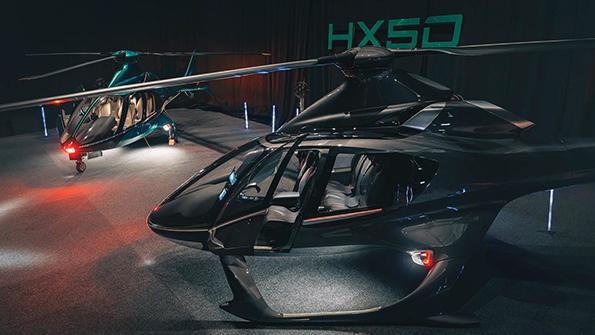
Two HX50s were unveiled on Dec. 6, one equipped with skids, the other with wheeled landing gear. First flight is planned for 2024.
With an order backlog of almost 1,000 aircraft and growing, British startup Hill Helicopters has finally lifted the veil on the first prototypes of its HX50 turbine-powered light rotorcraft.
At the debut of the first aircraft during a glitzy event at Duxford, England, on Dec. 6, company founder Jason Hill suggested that his helicopters could also find a role in advanced air mobility ahead of the wider adoption of electric vertical-takeoff-and-landing (eVTOL) aircraft. “People are asking questions about the future of the helicopter,” Hill told customers. “The helicopter has a bright future,” he insisted, but only if aircraft are designed so that those operating them can be “profitable again.”
- Hill offering two versions of five-seat helicopter
- Testing on GT50 engine beginning imminently
- Public opposition has altered production plans
Hill said helicopters such as the certified variant of the HX50, the HC50, could make commercial operations viable again because of its performance and low costs. “The world will have to wait a little while for the batteries to be good enough to make some of the other [eVTOL] configurations truly economically viable,” he said.
Hill’s Green-VTOL initiative calls for HX/HC50 customers to make use of sustainable aviation fuels, particularly as many of them will operate their helicopters from their homes, requiring them to take delivery of their fuel. Keeping costs down would be possible thanks to what he called “end-to-end control [by the manufacturer] of the purchase costs and spares,” which he said would drive down the cost of insurance.
Ever since he formally launched the company, Hill had set out to challenge the general aviation industry by delivering an aircraft developed primarily for private ownership and making possession of a helicopter as attractive as, for example, buying a high-performance car.
Hill wants to do this by reducing the barriers to ownership and keeping costs down, made possible in part through the complete vertical integration of the company’s supply chain and manufacturing process. This effort includes internal development of the HX/HC50’s propulsion, the 500-shp HT50 engine. However, no engine had been run by the unveiling event, leaving the almost completed aircraft in the unusual position of being without a powerplant.
Although under development for more than a decade through Hill’s other company—Dynamiq Engineering—the engine’s design has had to go through a refresh, previously referred to as GT50 V2.0, a redesign of the combustion system. Engineers are set to imminently begin testing this combustion system to prove out the fuel system for engine start and stable combustion, Hill said. He added that the company now has the experience and materials in-house to cast superalloys for fan blades and engine rotors and produce them at what he called an unprecedented price point.
“Aerospace companies need to be manufacturing companies,” he told customers. “They cannot be technology companies and push the manufacturing out to a third party, because you will lose control of the price point.”
In terms of the engine itself, Hill described it as a “compendium” of the best ideas in turbine engines. “We have done a good job of bringing them together,” he insisted.
Other elements developed in-house include the aircraft’s avionics suite, which can be integrated with a tablet computer for navigation, while haptic controls inform the pilot when limits are being reached.
The current target for first flight of the 1,650-kg (3,600-lb.), five-seat shark-like helicopter is 2024, although Hill’s original timelines called for market entry during 2023. The delays do not seem to have deterred customers—individuals from more than 60 countries have signed up to purchase 789 HX50s and 186 of the certified HC50s.
The HX50 is being made available to buy under the experimental homebuilt category. It is designed to be assembled on Hill’s production line. But the process will require the owners to attend a build course at the company’s factory and participate in the process of building their aircraft—planned to be around two weeks.
The more expensive fully certified HC50—priced at £725,000 ($910,000)—will be identical to the HX50 and built in the same facility. To prepare for the demand, Hill is also gearing up for production of the aircraft.
Original plans called for the conversion of an industrial unit in the English Midlands with production and flight operations on the same site, but the company faced public opposition to the proposals. The company is now hoping for a dual-site approach, with manufacturing in one location and flying operations to be performed at a separate 10-acre site at Halfpenny Green Airfield near Wolverhampton, England.

Comments